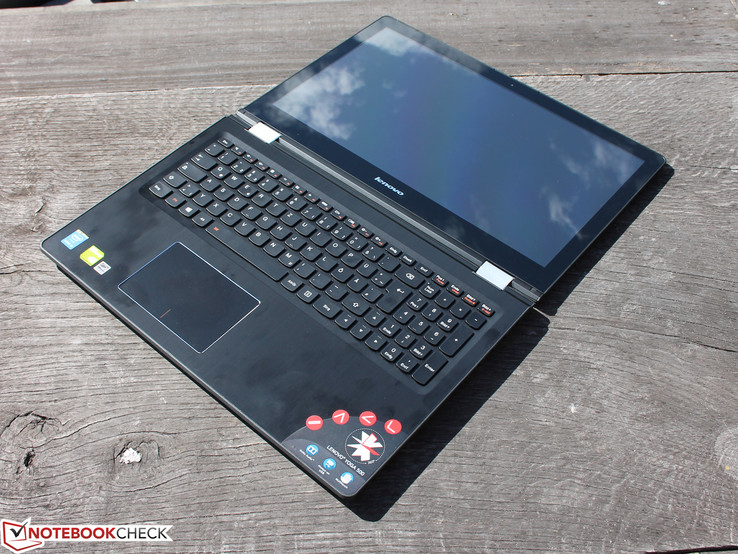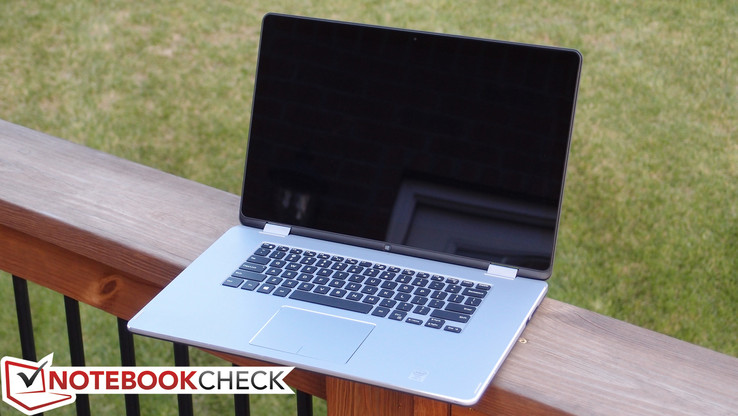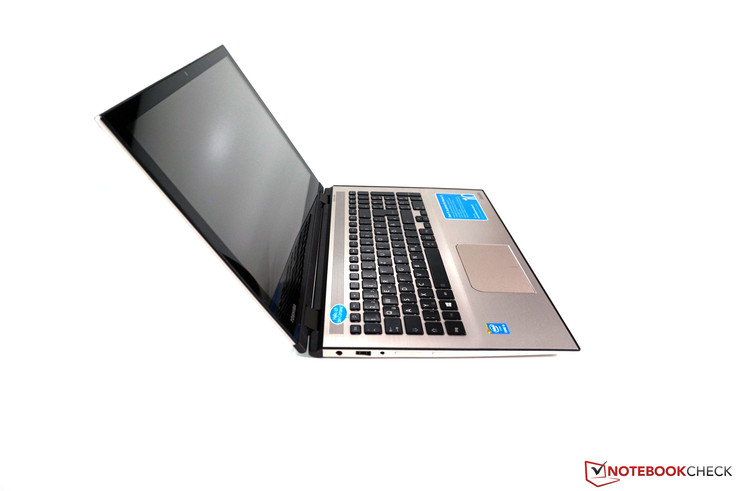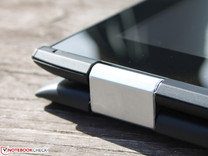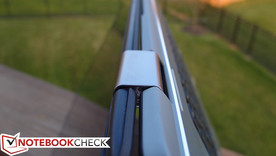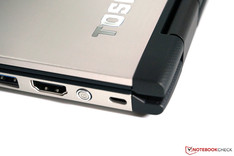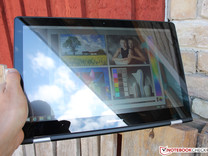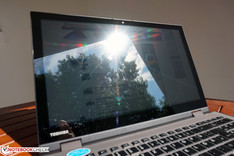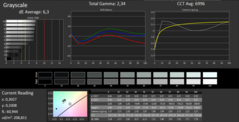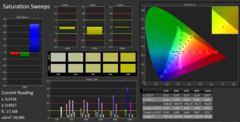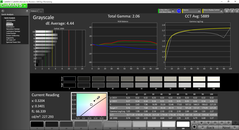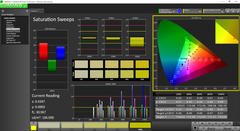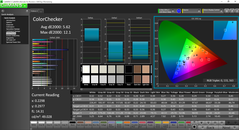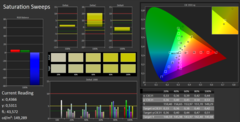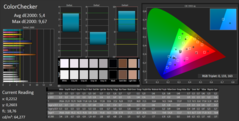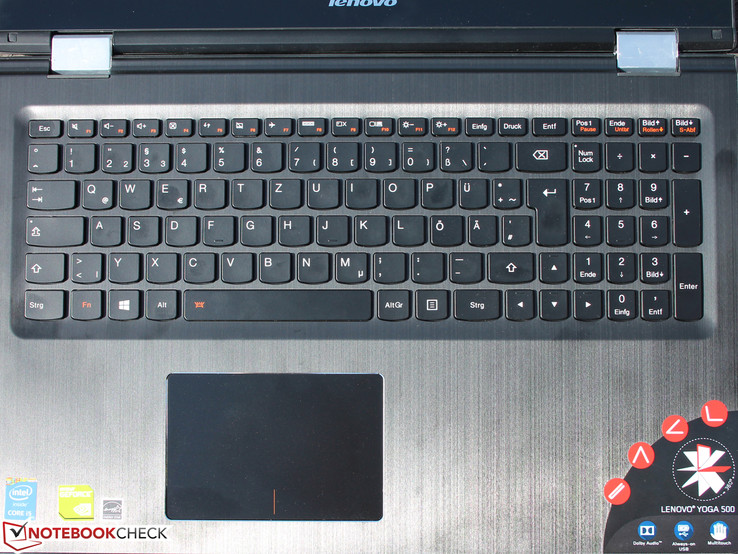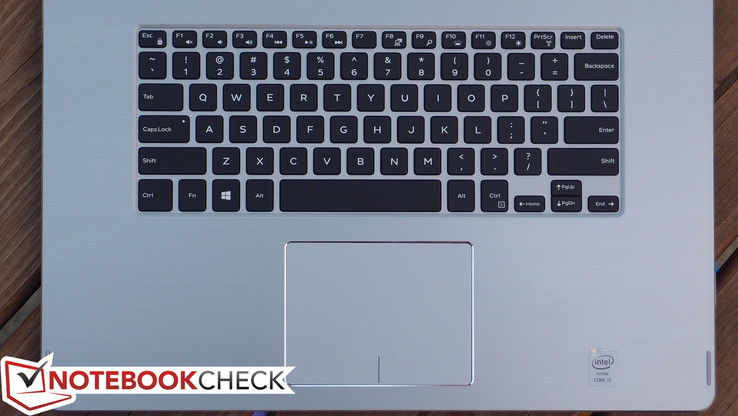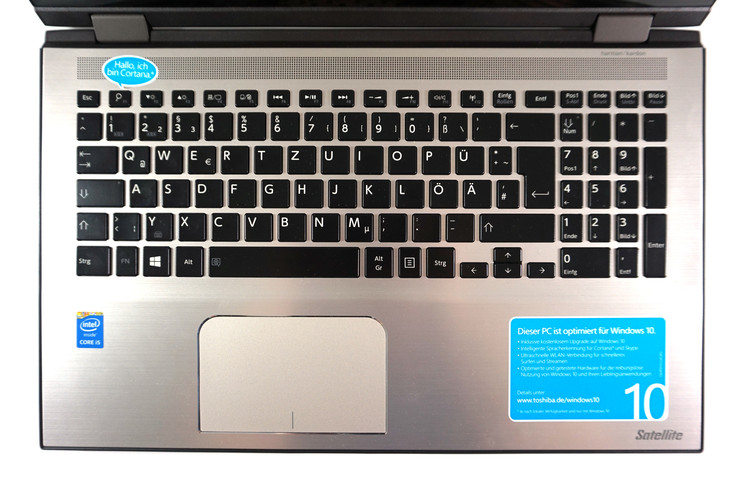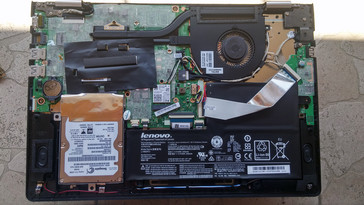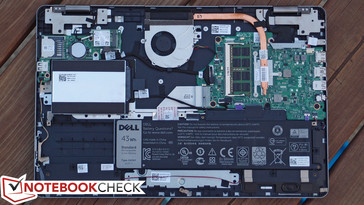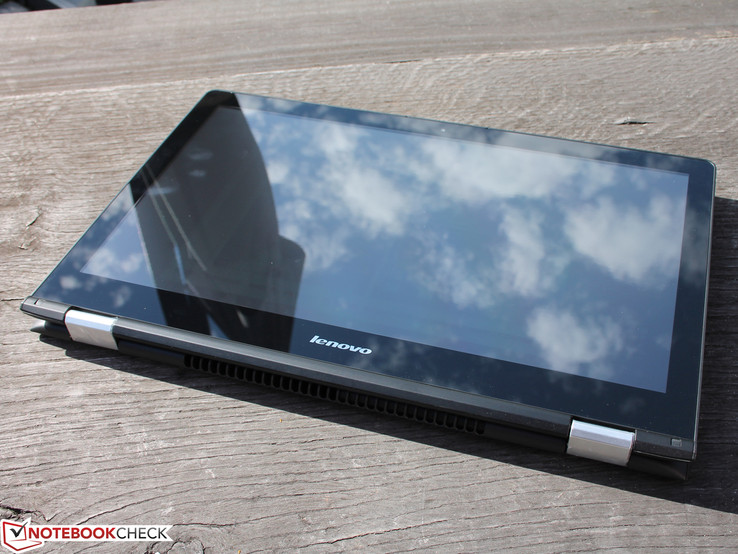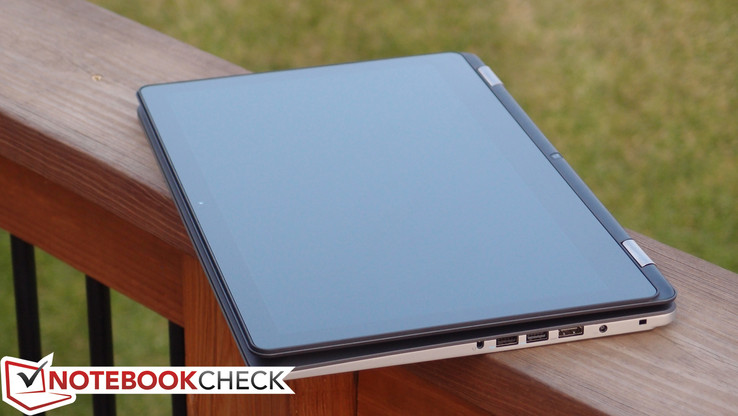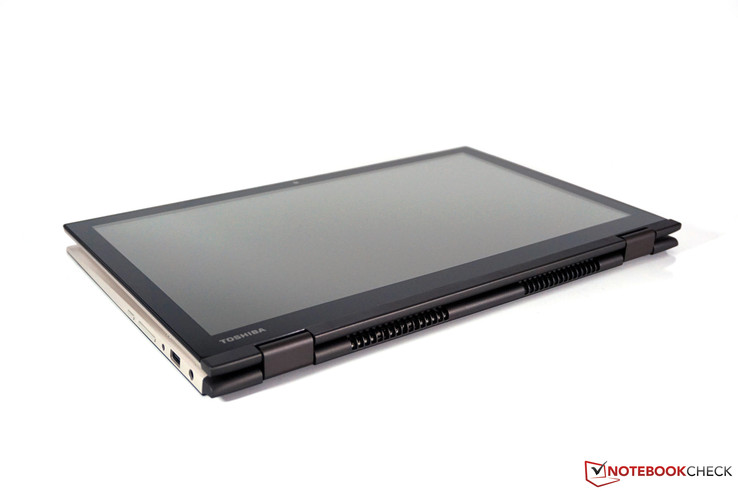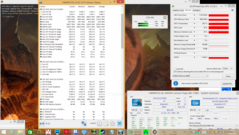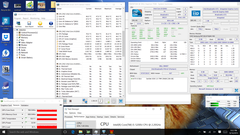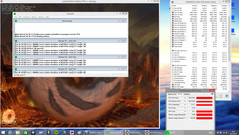Face Off: Lenovo Yoga 500 vs. Dell Inspiron 15 7000 2-in-1 vs. Toshiba Satellite Radius 15

The traditional notebook is changing as manufacturers are investing more into hybrid designs to appease both sides of the consumer base. These convertible 2-in-1 devices are becoming increasingly common for both mainstream and business sectors.
The full rotation 360-degree hinges are one of the earliest convertible designs made popular by the Lenovo Yoga series. For this Face Off, we'll compare how the recently released Yoga 500 holds up against others like it. Is the Dell Inspiron 15 7000 or Toshiba Satellite Radius 15 a better deal overall?
We encourage users to check out our dedicated review pages below for more data and detailed analyses of each of the three models. This comparison is by no means a replacement, but a condensed aid for those on the fence.
Toshiba Satellite Radius 15 P50W-C Review (Satellite Radius 15 P50W 2014)
Case
Hinge design is always tricky for convertibles and detachables compared to traditional notebooks. The inherently uneven weight distribution for detachables makes it especially difficult while 360-degree hinges must be rigid and reliable no matter the angle. Fortunately for Lenovo, Dell, and Toshiba, the Yoga 500, Inspiron 15 7000, and Radius 15 all have strong hinges with no major issues. The hinges on the Toshiba could have been firmer, however, as the display tends to rock back and forth a bit more easily than on the Lenovo or Dell.
Overall case quality for each model is a mixed bag. This is a notable issue when designing 15.6-inch convertibles as weight must be kept to a minimum in order to create a more comfortable tablet experience at the cost of case rigidity. The lids of the three models are more susceptible to twisting and damage as a result and are certainly flimsier than say a traditional ThinkPad, Latitude, or Portege.
The plastic and brushed aluminum base of the Yoga 500 makes for a good impression with only slight twisting possible. The Dell is even better with its stronger and flashier construction. Its base is more resistant to twisting, though slight warping is still possible when pushing down on the center of the keyboard. The Radius 15 comes in last in terms of durability as its base is easy to dent and creaking can be heard when attempting to twist it side-to-side. Furthermore, the lid does not lie completely flat against the base in tablet mode and the resulting gap makes for a more uncomfortable experience.
As for size and weight, the Yoga 500 is the largest and thickest partly due to its dedicated Nvidia GPU while the Radius 15 has the smallest footprint. Each model weighs just over 2.1 kg. While there are certainly flaws in each, the Dell convertible gives the more solid impression especially against the Toshiba.
Winner: Dell Inspiron 15 7000
Connectivity
Available ports are largely identical between the models save for one omission. The Yoga 500 is the only one out of the three with an Ethernet port. Otherwise, options are more limited compared to standard 15.6-inch notebooks as the rear edges must be kept free in order for the 360-degree hinges to work properly.
Another small difference is the location of the Windows Home button. The button is immediately below the display on the Dell and is on the left edge of the Toshiba. The Lenovo skips the button entirely, but instead includes a handy rotation lock to quickly disable the gyroscope when desired.
The slight edge goes to Lenovo for its dedicated RJ-45 port. Otherwise, users won't be missing much if on the Dell or Toshiba.
Winner: Lenovo Yoga 500
| Lenovo Yoga 500 | Dell Inspiron 15 7000 | Toshiba Satellite Radius 15 | |
| USB | 2x USB 3.0, 1x USB 2.0 | 2x USB 3.0, 1x USB 2.0 | 2x USB 3.0, 1x USB 2.0 |
| Video-out | 1x HDMI | 1x HDMI | 1x HDMI |
| Other | SD reader, 1x 3.5 mm audio, Gigabit RJ-45, Kensington Lock, Rotation lock | SD reader, 1x 3.5 mm audio, Kensington Lock | SD reader, 1x 3.5 mm audio, Kensington Lock, Windows Button |
| Wireless | 802.11 a/b/g/n/ac, Bluetooth 4.0 | 802.11 a/b/g/n, Bluetooth 4.0 | 802.11 a/b/g/n/ac, Bluetooth 4.0 |
| Storage Bays | 1x 2.5-inch SATA III | 1x 2.5-inch SATA III | 1x 2.5-inch SATA III |
Display
All panels provide sharp texts and images and are thankfully IPS panels, so users can switch between Portrait and Landscape mode without any viewing angle issues. The displays also exhibit no major responsiveness issues when used as touchscreens.
With the basics out of the way, we instead want to compare color accuracy, brightness, and contrast. The Toshiba comes out ahead in all three categories as it uses a stronger backlight with deeper black levels and a wider color gamut than both the Lenovo and Dell. Most users may not notice the color differences during day-to-day use, but the higher contrast and brightness are much more desirable for both general work and multimedia use.
It's worth noting that maximum brightness on the Toshiba will drop to just 237 nits when running on batteries, though this is fortunately still higher than the Dell and Lenovo. Users might be able to lift this artificial brightness ceiling through the Intel Power Management settings.
Winner: Toshiba Satellite Radius 15
| Lenovo Yoga 500 | Dell Inspiron 15 7000 | Toshiba Satellite Radius 15 | |
| Size | 15.6-inch AH-IPS | 15.6-inch IPS | 15.6-inch IPS |
| Native Resolution | 1920 x 1080 | 1920 x 1080 | 1920 x 1080 |
| Pixel Density | 141 PPI | 141 PPI | 141 PPI |
| Panel ID | LG Philips LP156WF4_SPL1 | BOE0648 | LG Philips LP156WF6_SPA1 |
| Panel | Glossy | Glossy | Glossy |
| Lenovo Yoga 500-15IBD | Dell Inspiron 15 7558 | Toshiba Satellite Radius 15 P50W-C-102 | |
|---|---|---|---|
| Display | |||
| Display P3 Coverage (%) | 39.36 | 42.35 | 64.4 |
| sRGB Coverage (%) | 59 | 63.5 | 83.2 |
| AdobeRGB 1998 Coverage (%) | 40.68 | 43.77 | 60.8 |
| Screen | |||
| Brightness middle (cd/m²) | 205 | 208.6 | 293 |
| Brightness (cd/m²) | 206 | 204 | 287 |
| Brightness Distribution (%) | 87 | 91 | 91 |
| Black Level * (cd/m²) | 0.28 | 0.248 | 0.25 |
| Contrast (:1) | 732 | 841 | 1172 |
| Colorchecker dE 2000 * | 6.68 | 5.62 | 5.4 |
| Greyscale dE 2000 * | 6.3 | 4.44 | 4.33 |
| Gamma | 2.34 94% | 2.06 107% | 2.39 92% |
| CCT | 6996 93% | 5889 110% | 6670 97% |
| Color Space (Percent of AdobeRGB 1998) (%) | 37 | 40.2 | 55 |
| Color Space (Percent of sRGB) (%) | 59 | 63.1 | 83 |
| Total Average (Program / Settings) |
* ... smaller is better
Input Devices
Lenovo's AccuType keyboard wins this round without much of a fight. A quick look at the layout of each model will show that the Yoga 500 has both full-size Arrow keys and a NumPad compared to the Dell and Toshiba. However, this does come at the cost of a smaller "0" key. Dell had likely omitted the NumPad altogether in order to make it easier to use the the convertible in tablet mode. Nonetheless, the empty space feels like a missed opportunity to add additional speakers or even a fingerprint reader. In terms of feedback, the Toshiba keys tend to rattle more easily and feel a bit cheaper as result. Travel is shallow across the board, but pressure point is clearest on the Lenovo.
Touchpad performance is about the same between the Lenovo and Dell with good gliding characteristics and shallow-but-firm integrated mouse keys on both. However, we prefer the touchpad on the Dell as its base construction is superior to Lenovo's and its white surface is better at hiding fingerprints. Meanwhile, the touchpad on our Toshiba is wobbly and even rattles when pressed. This may simply be an issue with our specific test unit, but we have our doubts based on the already subpar construction quality of the lid and base.
Finally, touchscreen responsiveness is excellent across all three models. The practicality and ergonomics of such a feature on a convertible, however, will be up to the user to decide. A common annoyance on this type of notebook is that the Power and Volume buttons are usually around the edges similar to standard tablets. Since these convertibles are much larger and heavier, however, two hands are almost always required and it can be easy to accidentally power off or adjust volume.
Winner: Keyboard -- Lenovo Yoga 500
Touchpad -- Dell Inspiron 15 7000
Performance
CPU Performance
Lenovo, Dell, and Toshiba all offer multiple CPU options beyond what we have here, so this comparison is only between the configurations on hand.
Coincidentally, our three in-house units all carry identical Core i5 Broadwell processors with 8 GB of single-channel RAM each. One SODIMM slot is available on the Lenovo and Dell, though we cannot yet confirm on the Toshiba. The maintenance panels on Yoga 500 and Inspiron 15 are more easily removable compared to the Radius 15, which we were unsuccessful in removing without needing to damage the chassis. Its official Toshiba manual does not recommend opening up the notebook, so there is a greater risk of voiding the warranty compared to the Lenovo and Dell.
CineBench and even PCMark 8 scores are very similar between the three notebooks due largely to having minimal hardware differences. This means no one model is artificially throttling the CPU for thermal or power reasons under typical load conditions.
See our dedicated CPU pages on the Core i5-5200U for more comparisons and benchmarks.
| Lenovo Yoga 500 | Dell Inspiron 15 7000 | Toshiba Satellite Radius 15 | |
| CPU | 2.2 GHz Core i5-5200U | 2.2 GHz Core i5-5200U | 2.2 GHz Core i5-5200U |
| TDP | 15 W | 15 W | 15 W |
| RAM | 8 GB DDR3 1600 MHz, 1x SODIMM slot | 8 GB DDR3 1600 MHz, 1x SODIMM slot | 8 GB DDR3L 1600 MHz, (# of SODIMM slots unlisted) |
| GPU | Nvidia GeForce 940M | Intel HD Graphics 5500 | Intel HD Graphics 5500 |
| Cinebench R15 | |
| CPU Single 64Bit (sort by value) | |
| Lenovo Yoga 500-15IBD | |
| Dell Inspiron 15 7558 | |
| Toshiba Satellite Radius 15 P50W-C-102 | |
| CPU Multi 64Bit (sort by value) | |
| Lenovo Yoga 500-15IBD | |
| Dell Inspiron 15 7558 | |
| Toshiba Satellite Radius 15 P50W-C-102 | |
| Cinebench R11.5 | |
| CPU Single 64Bit (sort by value) | |
| Lenovo Yoga 500-15IBD | |
| Dell Inspiron 15 7558 | |
| Toshiba Satellite Radius 15 P50W-C-102 | |
| CPU Multi 64Bit (sort by value) | |
| Lenovo Yoga 500-15IBD | |
| Dell Inspiron 15 7558 | |
| Toshiba Satellite Radius 15 P50W-C-102 | |
| Cinebench R10 | |
| Rendering Single CPUs 64Bit (sort by value) | |
| Dell Inspiron 15 7558 | |
| Toshiba Satellite Radius 15 P50W-C-102 | |
| Rendering Multiple CPUs 64Bit (sort by value) | |
| Dell Inspiron 15 7558 | |
| Toshiba Satellite Radius 15 P50W-C-102 | |
| Super Pi Mod 1.5 XS 32M - 32M (sort by value) | |
| Dell Inspiron 15 7558 | |
| 3DMark | |
| 1280x720 Cloud Gate Standard Physics (sort by value) | |
| Lenovo Yoga 500-15IBD | |
| Dell Inspiron 15 7558 | |
| 1920x1080 Fire Strike Physics (sort by value) | |
| Lenovo Yoga 500-15IBD | |
| Dell Inspiron 15 7558 | |
| PCMark 7 | |
| Score (sort by value) | |
| Lenovo Yoga 500-15IBD | |
| Dell Inspiron 15 7558 | |
| Toshiba Satellite Radius 15 P50W-C-102 | |
| Lightweight (sort by value) | |
| Lenovo Yoga 500-15IBD | |
| Productivity (sort by value) | |
| Lenovo Yoga 500-15IBD | |
| Entertainment (sort by value) | |
| Lenovo Yoga 500-15IBD | |
| Creativity (sort by value) | |
| Lenovo Yoga 500-15IBD | |
| Computation (sort by value) | |
| Lenovo Yoga 500-15IBD | |
| System Storage (sort by value) | |
| Lenovo Yoga 500-15IBD | |
| PCMark 8 | |
| Work Score Accelerated v2 (sort by value) | |
| Lenovo Yoga 500-15IBD | |
| Dell Inspiron 15 7558 | |
| Toshiba Satellite Radius 15 P50W-C-102 | |
| Creative Score Accelerated v2 (sort by value) | |
| Dell Inspiron 15 7558 | |
| Home Score Accelerated v2 (sort by value) | |
| Lenovo Yoga 500-15IBD | |
| Dell Inspiron 15 7558 | |
| Toshiba Satellite Radius 15 P50W-C-102 | |
| X264 HD Benchmark 4.0 | |
| Pass 1 (sort by value) | |
| Dell Inspiron 15 7558 | |
| Pass 2 (sort by value) | |
| Dell Inspiron 15 7558 | |
* ... smaller is better
GPU Performance
The dedicated Nvidia 940M GPU inside the Yoga 500 is perhaps the biggest difference between the three models in terms of internal hardware features. Raw performance is over twice that of the integrated 5500 in CineBench and 3DMark benchmarks with the performance lead translating well into higher frame rates across the board. We recommend checking out our dedicated benchmarks page for both the GT 940M and HD 5500 for more comparisons and gaming benchmarks.
Winner: Lenovo Yoga 500
| Cinebench R15 - OpenGL 64Bit (sort by value) | |
| Lenovo Yoga 500-15IBD | |
| Dell Inspiron 15 7558 | |
| Toshiba Satellite Radius 15 P50W-C-102 | |
| 3DMark 11 - 1280x720 Performance GPU (sort by value) | |
| Dell Inspiron 15 7558 | |
| 3DMark | |
| 1280x720 Cloud Gate Standard Graphics (sort by value) | |
| Lenovo Yoga 500-15IBD | |
| Dell Inspiron 15 7558 | |
| 1920x1080 Fire Strike Graphics (sort by value) | |
| Lenovo Yoga 500-15IBD | |
| Dell Inspiron 15 7558 | |
| Cinebench R11.5 - OpenGL 64Bit (sort by value) | |
| Lenovo Yoga 500-15IBD | |
| Dell Inspiron 15 7558 | |
| Toshiba Satellite Radius 15 P50W-C-102 | |
Stress Test
To test system stability, we run both Prime95 and FurMark to simulate maximum stress. These unrealistic conditions do not represent daily workloads, but are instead meant to put both the CPU and GPU at 100 percent capacity. If the notebook remains stable, then you can be sure it can handle any other tasks without major hardware failures.
The Yoga 500 performs very well when under extreme stress conditions. The GPU is able to maintain Boost speeds while CPU dips to a stable 300 - 400 MHz below its base clock rate. Thus, the system is prioritizing graphics performance at the cost of lower CPU speeds and higher core temperatures.
The Dell performs the worst as its CPU and GPU stabilize at lower clock rates. Turbo Boost is in effect until core temperature reaches 80 - 81 C. Afterwards, the CPU stabilizes at a low 70 C.
CPU and GPU clock speeds never throttle on the Toshiba. The CPU is able to maintain a 300 MHz Turbo Boost without needing to throttle the GPU, which is impressive for a thin notebook let alone a convertible with integrated graphics. Toshiba has specifically allowed the Radius 15 to operate above its TDP limit of 15 Watts to improve performance when under stress and it can certainly pay off if running intensive CPU and GPU applications for long stretches of time.
Winner: Toshiba Satellite Radius 15
| Lenovo Yoga 500 | Dell Inspiron 15 7000 | Toshiba Satellite Radius 15 | |
| Rated GPU Core Clock (MHz) | 1072 | 900 | 900 |
| Stable GPU Core Clock on FurMark (MHz) | 1176 | 700 - 750 | 900 |
| Rated CPU Core Clock (GHz) | 2.2 | 2.2 | 2.2 |
| Stable CPU Core Clock on Prime95 (GHz) | 1.8 - 1.9 | 1.5 | 2.5 |
| Maximum CPU temperature | 82 C | 70 - 81 C | 78 C |
| Maximum GPU temperature | 80 C | -- | -- |
Emissions
System Noise & Temperature
All three notebooks are quiet under low load conditions, but only the Dell is truly silent as its fan can idle completely. The fan in the Yoga 500 tends to fluctuate more often while the Dell suffers from coil noise. In either case, both are at low enough levels to be of no concern during daily workloads. The Dell continues to be the quieter notebook when under maximum stress.
Average surface temperature is warmer on the Dell when under low loads likely due in part to its idling fan. Consequently, this same notebook has the steeper temperature gradient with a maximum recorded temperature of just over 36 C on the bottom corner of the notebook from sitting idle on the desktop. This is compared to 30 C on both the Lenovo and Toshiba.
The results are similar when under very high loads. The hot spot on the Dell can be over 50 C compared to 42 C and 46 C on the Lenovo and Toshiba, respectively. While the Lenovo is cooler overall, its keyboard warms up very unevenly compared to the Toshiba for a more uncomfortable typing experience under high loads. On the flip side, this can be good for gaming as the WASD keys remain cool. This is again dependent on user preference.
Winner: System Noise -- Dell Inspiron 15 7000
Surface Temperature -- Tie -- Lenovo Yoga 500 & Toshiba Satellite Radius 15
| Lenovo Yoga 500 | Dell Inspiron 15 7000 | Toshiba Satellite Radius 15 | |
| Fan Noise when idling | 31.9 - 32.7 dB(A) | 28.2 dB(A) | 32.9 dB(A) |
| Fan Noise under high loads | 40.6 dB(A) | 33.1 dB(A) | 37.1 - 43.1 dB(A) |
| Average surface temperature when idling | 27.2 C | 30.3 C | 29.4 C |
| Average surface temperature under high loads | 32.1 C | 34.8 C | 34.9 C |
| Ambient temperature | 24.8 C | 24.3 C | 24.9 C |
Battery Life
The Yoga 500 walks out as the loser in this round without putting up much of a fight. Its lower capacity battery and more demanding dedicated GPU are both bad news in terms of battery life. Runtimes are hours shorter than the Dell and Toshiba even with Optimus enabled.
The Toshiba and Dell are close, but it's the Toshiba that pulls out over an hour ahead in our standard WiFi test. The data below is provided in minutes before automatic shutdown.
Unfortunately for all three notebooks, the internal battery packs cannot be easily swapped or removed.
Winner: Toshiba Satellite Radius 15
| Lenovo Yoga 500-15IBD 30 Wh | Dell Inspiron 15 7558 43 Wh | Toshiba Satellite Radius 15 P50W-C-102 45 Wh | |
|---|---|---|---|
| Battery runtime | |||
| Reader / Idle (h) | 7.8 | 14.8 | 11.6 |
| WiFi v1.3 (h) | 2.6 | 4.9 | 6 |
| Load (h) | 1.8 | 2 | 2.1 |
Verdict
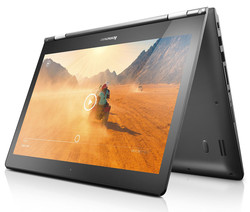
There's no doubt that opting in for a convertible 2-in-1 has its drawbacks compared to a standard notebook. Fewer connectivity ports, clunkier tablet mode, non-removable battery, and generally reduced stability are just a few to keep in mind. However, we're here to pick the better convertible - not to criticize the form factor in question.
Firstly, the Toshiba can be immediately crossed off of our list due to its poorer build quality and questionable longevity. It is simply less durable and more prone to nicks and dents compared to the Lenovo and Dell. This is truly unfortunate considering that its screen is far superior in essentially every way.
Choosing between the Yoga 500 or Inspiron 15 7000 will depend largely on the gaming habits of the user. The GT 940M is the strongest wild card in Lenovo's favor that can both seal the deal for casual gamers and mean little to office users. Thus, there is no definitive winner as there are alternating pros and cons for the two notebooks.
The HP Spectre 13 x360 is the suggested alternative, though this comes in a smaller 13.3-inch screen size.
| Lenovo Yoga 500 | Dell Inspiron 15 7558 | Toshiba Satellite Radius 15 |
|---|---|---|
+ Discrete Nvidia graphics + Better keyboard + NumPad and full-size Arrow keys + Gigabit Ethernet + Easier maintenance | + Lower fan noise + Stronger build quality + Easier maintenance | + Brighter and more accurate display + Higher capacity battery; longer battery life + Excellent CPU and GPU performance under stress + NumPad |
- Shorter battery life - Thicker and larger - Least accurate display | - No NumPad - Smaller Arrow keys - Throttling under extreme loads - Higher surface temperatures | - Difficult maintenance - Smaller Arrow keys - Poorer overall build quality - Lower quality touchpad |
See more quick comparisons in our Face Off series:
- Dell XPS 15 vs. Apple MacBook Pro 15 vs. Asus ZenBook Pro UX501
- Aorus X3 Plus vs. Gigabyte P34W vs. Razer Blade 14
- Dell XPS 13 vs. Apple MacBook Pro 13 vs. Asus ZenBook UX305
- HP EliteBook 820 G2 vs. Lenovo ThinkPad X250 vs. Dell Latitude 12 E7250
- Asus ROG G751 vs. Dell Alienware 17 vs. MSI GT72 Dominator
- Lenovo ThinkPad T450 vs. Acer TravelMate P645 vs. Dell Latitude 14 E5450
- Dell Alienware 15 vs. Clevo P751ZM vs. MSI GE62
- Acer Aspire V17 Nitro vs. Asus N751 vs. HP Envy 17
- Samsung Galaxy Tab S 8.4 vs. Sony Xperia Z3 Compact vs. Dell Venue 8 7000
- Asus EeeBook X205TA vs. Lenovo S20 vs. Acer Aspire ES1
- Microsoft Surface Pro 3 vs. Asus Transformer Book T300 Chi vs. Toshiba Portege Z20t
- Lenovo ThinkPad Edge E550 vs. Acer Aspire E5 vs. HP ProBook 450 G2
- HP Pavilion 15 vs. Lenovo IdeaPad Z50 vs. Toshiba Satellite S50
- Apple MacBook Air 13 2015 vs. Samsung ATIV Book 9 900X3G vs. Asus ZenBook UX303
- Asus ROG G501 vs. Lenovo Y50 vs. Acer Aspire V15 Nitro
- OnePlus 2 vs. Honor 6 Plus vs. Motorola Moto X Play




